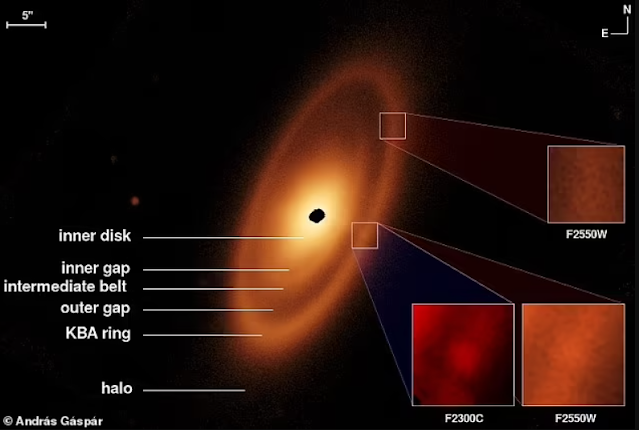Incredible new images from NASA's James Webb Space Telescope (JWST) reveal a solar system in greater detail than ever before.
Fomalhaut is a star approximately 25 light years from Earth with a striking surrounding belt of dust that stretches out 14 billion miles.
Scientists have revealed that two innermost belts also surround the star, as well as a 'Great Dust Cloud', thanks to new data from the $10 billion telescope.
Researchers previously thought they found a planet around Fomalhaut, although it was later deemed to be remains of a cosmic collision.
However, detection of these new belts around Fomalhaut could be the strongest indication yet that it does have planets – possibly with alien life.
A study describing the findings, led by András Gáspár at the University of Arizona, has been published today in Nature Astronomy.
'Fomalhaut appears to be the site of a complex and possibly dynamically active planetary system,' they say.
The 440-million-year-old star has a mass around 1.92 times that of our sun and is located in the constellation of Piscis Austrinus, approximately 25 light years away.
Fomalhaut is one of the brightest stars in the night's sky – 15 times as bright as our sun – and it is blazing through hydrogen at such a furious rate that it will burn out in just one billion years.
We now know that there are three belts around Fomalhaut: two inner ones that were previously unknown and one outer, previously known.
The outermost one extends out to 14 billion miles (23 billion kilometers) from the star – around 150 times the distance of Earth from our sun.
Fomalhaut's three belts together all form a prominent 'debris disk' – a surrounding cluster of cosmic dust, pebbles and other remnants from rocky collisions of the past.
For their study, the experts analyzed images taken of the debris system around Fomalhaut using JWST's Mid-InfraRed Instrument (MIRI), which sees light in the mid-infrared region of the electromagnetic spectrum.
The images show the previously known outer ring in finer detail, which is considered 'analogous' or similar to our own solar system's Kuiper belt.
This doughnut-shaped ring of icy objects extends just beyond the orbit of Neptune and a 'region of leftovers from the solar system's early history' NASA says.
But Fomalhaut's two newly discovered inner belts were also revealed by Webb in infrared light for the first time.
This is exciting for astronomers because it hints at the possibility that Fomalhaut is analogous to our solar system, and that it may have planets like ours.
'The belts around Fomalhaut are kind of a mystery novel – where are the planets?' said study author George Rieke, US science lead for Webb's MIRI instrument.
'I think it's not a very big leap to say there's probably a really interesting planetary system around the star.'
The 'narrow' belt in the middle may be shepherded by the gravitational influence of unseen planets, suggesting the presence of a world in the gap between belts.
The newly discovered intermediate belt is also 'misaligned' compared with the outer belt and may have been the origin of a previously known dust cloud generated by a collision.
The images also reveal a large dust cloud within the outer ring, which the authors name the 'Great Dust Cloud'.
The Great Dust Cloud may be evidence for a collision occurring in the outer ring between two 'protoplanets' – large bodies of matter in orbit thought to be developing into a planet.
So either there are planets that have been in development around Fomalhaut, or others that have already existed for millions of years.
Either way, Fomalhaut and our own system have notable similarities, according to the experts.
'I would describe Fomalhaut as the archetype of debris disks found elsewhere in our galaxy, because it has components similar to those we have in our own planetary system,' said Gáspár.
'By looking at the patterns in these rings, we can actually start to make a little sketch of what a planetary system ought to look like – if we could actually take a deep enough picture to see the suspected planets.'
Reference(s): Nature Astronomy



















No comments